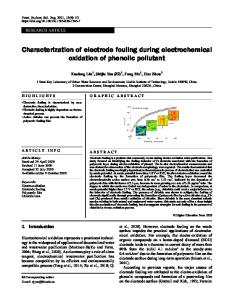Electrochemical activity of various types of aqueous In(III) species at a mercury electrode
- PDF / 796,168 Bytes
- 12 Pages / 595.276 x 790.866 pts Page_size
- 34 Downloads / 288 Views
ORIGINAL PAPER
Electrochemical activity of various types of aqueous In(III) species at a mercury electrode Raewyn M. Town 1,2 & Jérôme F. L. Duval 3 & Herman P. van Leeuwen 2 Received: 20 March 2020 / Revised: 11 April 2020 / Accepted: 16 April 2020 # Springer-Verlag GmbH Germany, part of Springer Nature 2020
Abstract An interpretation framework is presented which provides a straightforward means to characterise the electrochemical reactivity of aqueous ions together with their various hydrolysed counterparts. Our novel approach bypasses the more laborious strategy of solving rigorously, for all relevant species, the complete set of Butler-Volmer equations coupled to diffusion differential equations. Specifically, we consider the spatial variable via a Koutecký-Koryta type of differentiation between nonlabile and labile zones adjacent to the electrode. The theory is illustrated by an assessment of the electrochemical reactivity of aqueous In(III) species based upon proper comparison between relevant time scales of the involved interfacial processes, i.e. diffusion, (de)protonation of inner-sphere water, dissociation/release of H2O and OH−, and electron transfer. The analysis reveals that whilst all In(III) species are labile on the experimental timescale with respect to (de)protonation and (de)hydration, there are large differences in the rates of electron transfer between InðH2 OÞ3þ 6 and the various hydroxy species. Specifically, in the case of 3þ InðH2 OÞ6 , the rate of electron transfer is so slow that it replaces the traditional Eigen rate-limiting water release step in the overall passage from hydrated In3+ to its reduced metallic form; in contrast, the In(III) hydroxy species display electrochemically reversible behaviour. Keywords Electrochemical irreversibility . Indium . SSCP . Reaction layer . Lability
Introduction The electrochemical features of In(III) in aqueous solution are strongly pH-dependent. In(III) readily hydrolyses at low pH: see ref. [1] for a critical review of the literature on the hydrolysis constants. Literature from the 1960s evidences that
Electronic supplementary material The online version of this article (https://doi.org/10.1007/s10008-020-04607-0) contains supplementary material, which is available to authorized users. * Raewyn M. Town [email protected] 1
Systemic Physiological and Ecotoxicological Research (SPHERE), Department of Biology, Universiteit Antwerpen, Groenenborgerlaan 171, 2020 Antwerpen, Belgium
2
Physical Chemistry and Soft Matter, Wageningen University & Research, Stippeneng 4, 6708 WE Wageningen, The Netherlands
3
CNRS, Laboratoire Interdisciplinaire des Environnements Continentaux (LIEC), Université de Lorraine, F-54000 Nancy, France
voltammetric waves, recorded for free InðH2 OÞ3þ 6 with a dropping mercury electrode at a pH sufficiently low to suppress hydrolysis, show a drawn-out electrochemically irreversible wave for the InðH2 OÞ3þ 6 species with half-wave potential, E1/2, of − 0.95 V (vs. saturated calomel electrode (SCE)); as the pH is incr
Data Loading...











